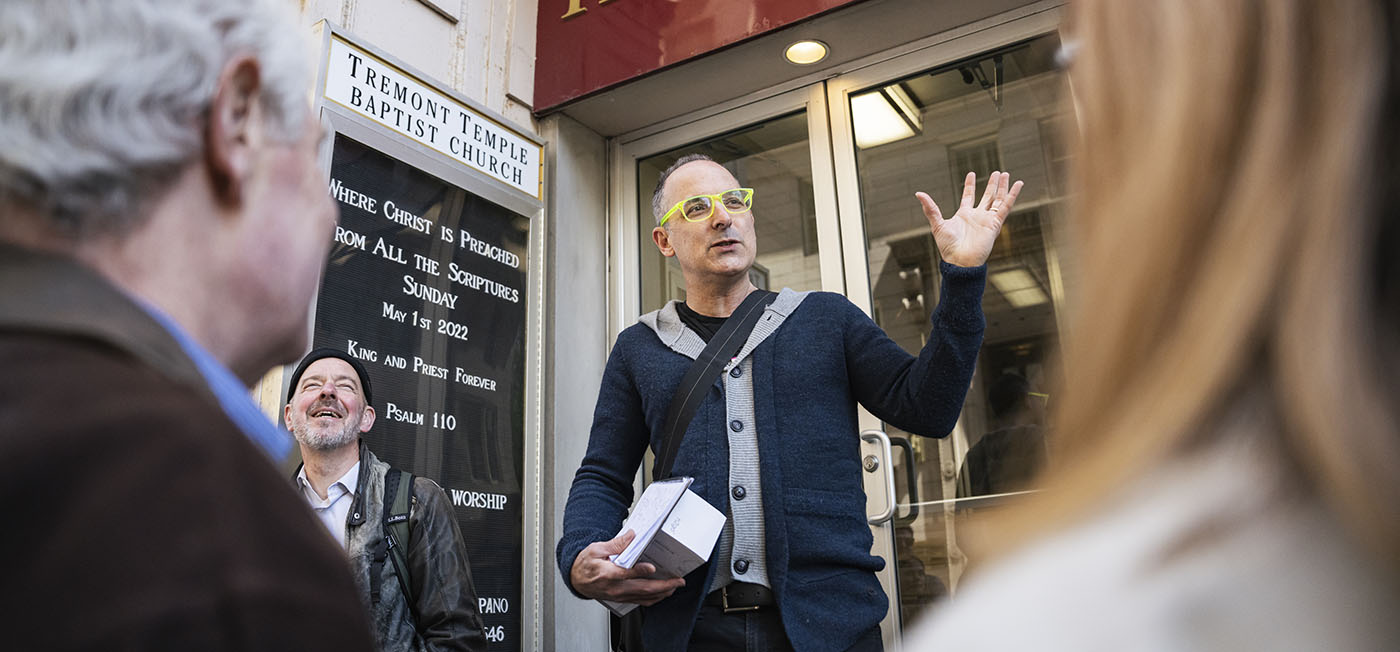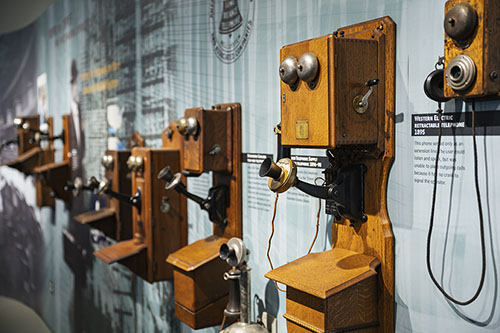Blazing Boston’s Innovation Trail
Journalist Scott Kirsner is on a mission to highlight the city’s culture of science and technology

Credit: Ben Gebo Photography bengebo.com
Scott Kirsner estimates that he’s written more than 1,000 “Innovation Economy” columns for the Boston Globe. Since launching the column in 2000, he’s covered shoe manufacturing and biotech startups, railroad car manufacturing and robots, cancer drugs and candy factories. Along the way, Kirsner (’93) began wondering how Greater Boston could better highlight its legacy and culture of science, technology and manufacturing innovation.
Kirsner and his friend Bob Krim, a writer and cofounder of Framingham State University’s Innovation Center, looked at maps, made lists of historic sites, networked with neighborhood groups and, inspired by the Freedom Trail, created a walk of their own: the Innovation Trail connects 21 sites between Boston’s Downtown Crossing and Cambridge’s Kendall Square, bridging the region’s manufacturing past with its biotech present.


Begin at the site of a 19th century patent office where Lewis Latimer, whose parents escaped slavery, helped Alexander Graham Bell and Thomas Edison draft patent filings, and end at Cambridge’s last operating candy factory, where Tootsie Roll Industries makes millions of Junior Mints each day. The trail includes the spot where Graham Bell invented the telephone and the building where scientists created the COVID vaccine. Some stops have visitor centers and exhibits, others exist only as a plaque on the sidewalk.
Kirsner spoke with COMtalk about designing the Innovation Trail and where he hopes it will lead.
Q&A
With Scott Kirsner
COMtalk: What sparked this idea?
Scott Kirsner: The Innovation Trail started as a COVID-era project. My friend Bob Krim and I were frustrated with COVID and we wanted a project that was outdoors. Bob is the preeminent innovation historian in Massachusetts and he just wrote a great book called Boston Made. He had run a nonprofit called the Boston History & Innovation Collaborative—they ran bus tours—and he and I had run fundraising tours where we would do a fun walking tour in Boston or in Cambridge. In June 2021 we started wondering how we could do something that would feel COVID-safe, and would build on the model of the Freedom Trail.
COMtalk: What were the first steps in creating this trail?
Scott Kirsner: We took a lean startup approach of “How much can we do with $0?” We convened a bunch of people in August 2021 and had a little bit of a walk around Kendall Square. We had folks there from the Kendall Square Association, which is a business group, and folks representing MIT and folks representing the Cambridge Innovation Center. It was a productive brainstorm.
COMtalk: And how did you determine what would be an official stop on the trail?
Scott Kirsner: It really is an editing and a curation job. There are four museums that are focused on STEM: the Museum of Science, MIT Museum, the Museum of Medical History and Innovation at Massachusetts General Hospital and the new Broad Discovery Center. That was the core. The other criteria was that you could see and experience something, take a picture and feel like you’re at an important place.
COMtalk: You’ve written about innovation for years. Did your research for the trail uncover any surprises?
Scott Kirsner: There’s still surprising stuff to discover. One example is the candy industry. There’s still one operating candy factory in Cambridge and we included that on the tour because it’s cool and most candy companies invent their own things. They don’t patent the equipment because, at some point, the patent would expire and then everybody else would see how to do it. So they’re just super secretive. If you don’t ever show it to anybody, then it’s a secret forever. Someone explained that to me when we were standing out in front of the last candy factory in Cambridge and I thought that was a pretty cool idea.
COMtalk: How does the Innovation Trail compare to Boston’s Freedom Trail?
Scott Kirsner: A similarity is that the Freedom Trail was also proposed by a newspaper columnist, in 1951. Within six months, the city of Boston decided to put up signs. We wanted to leverage the fact that when you say “trail” in Boston, people know what that is. But the Freedom Trail is about a very important moment in history. While the Innovation Trail is about history, it’s also about the present. And so I think it’s a little bit more relatable to people. You can talk about Technicolor—Technicolor is a company that was founded in Boston—people have seen The Wizard of Oz. Or you can stop at Google’s Kendall Square office and talk about how one of the cofounders of Android was a Boston-area guy. And Google is still inventing things in that building.
COMtalk: It’s remarkable that you created this during COVID and could put Moderna, one of the creators of a vaccine, on the trail.
Scott Kirsner: The biggest criteria that Bob and I had was, “Are these things that change the nation or the world?” And you could definitely say that bringing to market one of the first mRNA vaccines really did change the world. And right next door to Moderna is Draper Labs, where they created most of the navigation hardware and software that got Apollo to the moon.
COMtalk: The Freedom Trail follows a red line along Boston’s sidewalks and streets, but so far the Innovation Trail is a private project without official involvement from Boston or Cambridge, right?
Scott Kirsner: Through the COVID era, we felt like the cities had a lot of other stuff on their hands just trying to get kids back in school and to deliver the services that people expect. The last thing I wanted to do is harangue Boston and Cambridge about this. So, it exists as a website, there are printed brochures that hotels distribute and we also did a partnership with a tour company. So, there are a bunch of different ways to experience it, but we haven’t tackled the signage thing yet.
COMtalk: What is the long-term vision for the trail?
Scott Kirsner: One of the goals is to tell this story of the role that social innovation, business innovation and technological innovation have played here, because it is unique and special in the world. This cauldron or mixing pot of smart people from all over the world, and great educational institutions, and venture capital money, and work on energy problems and life sciences problems and technology problems—that’s really unique to us. We feel like this could be one of the top things that people do when they come to Boston. Now it’s the Freedom Trail and visiting Fenway Park and going to the Museum of Fine Arts—those are all awesome things, but we think this is awesome, too.
COMtalk: What is unique about Boston? You’ve spent most of your career writing about innovation here—why is this such a rich topic for you?
Scott Kirsner: This is such a multilayered place. I lived out in Silicon Valley for a couple of years and spent time hanging around Google headquarters and Apple headquarters and all of those places. It’s special in its own way. It wasn’t boring to write about innovation in San Francisco, but I think Boston is so motivated by discovering new things that are going to have an impact on people. It’s not so motivated by chasing riches and becoming crypto billionaires, or whatever. Silicon Valley has a great culture and there’s great people, but a lot of it is built around the pursuit of wealth and status and being able to build a trophy headquarters.
There was a conference in the early 1980s, in Boston, where the idea of quantum computing was first proposed. Here we are 40 years later and you can find startups that are working on quantum computing and finally figuring out how to turn that into a real business. You can always tell a deeper story by looking back; people have been thinking about quantum computing for decades and decades and it’s a hard problem that they’re still trying to crack. That feels like a very Boston thing to me.
This interview has been edited for clarity and brevity.


